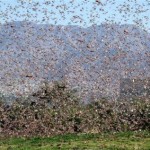Victorian farmers are in a phony war right now – but in spring the invasion will come. We’re likely to see the worst locust plague for 30 years. David Hunter will tell the conference how plagues occur and what can be done to reduce their impact.
IUPAC Symposium 4B – Smart Spray Application and Modelling Technologies Wednesday 4pm
David Hunter, Becker Underwood Australasia
“When locusts are at plague proportions, some damage is inevitable, but we can reduce the extent of damage with good integrated control,” says David. He will be talking about the cause of this plague and how it will be fought with a fungus – a biological control agent called Green Guard.
Tel: 02 6258 8214
Mobile: +61 (0) 400 360 200
Abstract
Locusts are controlled using an IPM system that aims to find most populations and rapidly treat them using a variety of products. Locusts in environmentally sensitive areas or on organic properties are treated using the biological agent Green Guard® that contains spores of the fungus Metarhizium. Dense bands of marching locusts are treated using the moderately persistent chemical fipronil applied in strips ~300m apart while swarms of flying adults are treated with faster acting organophosphorous compounds like fenitrothion.
All products are formulated and applied in ways that maximise effectiveness. Applications are as ULV formulations through micronairs adjusted so that 80% of the spray volume is in 50-150 micron droplets: such droplets maximise the number of lethal doses so that the doses required are less than half of those commonly used overseas, substantially reducing costs. Rapid application is also important: product is usually applied at 50-100m track spacings by aircraft flying at 10m height during a steady light 2-6m/sec wind.


